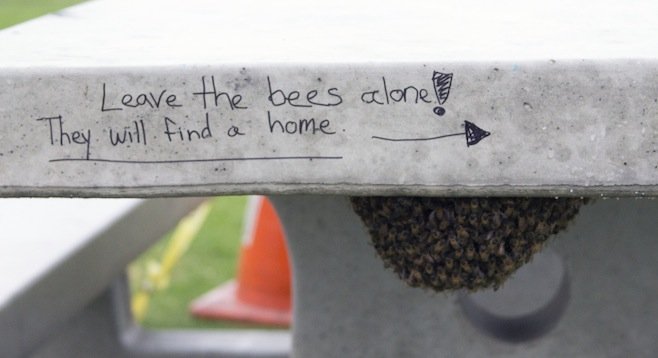 Facebook
Facebook
 X
X
 Instagram
Instagram
 TikTok
TikTok
 Youtube
Youtube

While the rest of the country was getting ready for the Fourth of July, city parks employees worked to remove a few hundred bees that had collected under a picnic table at Brighton Street Park in Ocean Beach.
The bees, which may have chosen the spot to maintain warmth and gather strength before swarming off in search of a suitable place to build a hive, were unknowingly awaiting a visit from an exterminator on the afternoon of July 3.
The bees had been reported to the San Diego Parks and Recreation Department June 27. With the beginning of Independence Day less than 24 hours away, Park and Rec could wait no longer for the insects to move along of their own accord. A city-contracted pest-control vendor had to be called in to take out the critters, said Dan Daneri, regional supervisor for shoreline parks.
“I was hoping the sprinklers would come on at night and chase them out,” Daneri said.
It’s common behavior for the insects to dogpile themselves into the shape of a mound, but they’re usually not building a hive, said Kurt Schuster of Pestmaster Services, the vendor that arrived late in the afternoon. A swarm that forms a ball and attaches itself to a picnic table, meter box, or light pole is usually between hives. This can happen for a variety of reasons — perhaps things got too crowded at the old hive. Typically, they rest up for a few days and fly off to build a new abode, Schuster said.
City crews encounter these great balls of bees three or four times a year, Daneri said. “They’re usually hanging on the side of a palm tree or something. They’re not defending a hive, so they’re in a peaceful state.”
Daneri acknowledged some may fret over the loss of the bees, but the city has no other options, he said. A contracted exterminator has insurance and bears the liability in case something goes awry, he said.
Schuster said he sprayed the swarm with pyrethrin, a natural organic compound derived from the chrysanthemum flower that attacks the nervous systems of bees. It causes them to freeze and land on a plastic bag, where they can be wrapped up and collected. The chemical is not harmful to the environment, he said.


While the rest of the country was getting ready for the Fourth of July, city parks employees worked to remove a few hundred bees that had collected under a picnic table at Brighton Street Park in Ocean Beach.
The bees, which may have chosen the spot to maintain warmth and gather strength before swarming off in search of a suitable place to build a hive, were unknowingly awaiting a visit from an exterminator on the afternoon of July 3.
The bees had been reported to the San Diego Parks and Recreation Department June 27. With the beginning of Independence Day less than 24 hours away, Park and Rec could wait no longer for the insects to move along of their own accord. A city-contracted pest-control vendor had to be called in to take out the critters, said Dan Daneri, regional supervisor for shoreline parks.
“I was hoping the sprinklers would come on at night and chase them out,” Daneri said.
It’s common behavior for the insects to dogpile themselves into the shape of a mound, but they’re usually not building a hive, said Kurt Schuster of Pestmaster Services, the vendor that arrived late in the afternoon. A swarm that forms a ball and attaches itself to a picnic table, meter box, or light pole is usually between hives. This can happen for a variety of reasons — perhaps things got too crowded at the old hive. Typically, they rest up for a few days and fly off to build a new abode, Schuster said.
City crews encounter these great balls of bees three or four times a year, Daneri said. “They’re usually hanging on the side of a palm tree or something. They’re not defending a hive, so they’re in a peaceful state.”
Daneri acknowledged some may fret over the loss of the bees, but the city has no other options, he said. A contracted exterminator has insurance and bears the liability in case something goes awry, he said.
Schuster said he sprayed the swarm with pyrethrin, a natural organic compound derived from the chrysanthemum flower that attacks the nervous systems of bees. It causes them to freeze and land on a plastic bag, where they can be wrapped up and collected. The chemical is not harmful to the environment, he said.
Comments